Port Saint-Etienne in Toulouse,
the commercial and administrative centre
of the Canal du Midi
Port Saint-Etienne was built in the 18th century. Facing the city of Toulouse, Port Saint-Etienne overlooks the canal. This was where all the political, administrative and commercial services for this unique inland waterway were concentrated, including the chamber of justice for the canal seigneury, the Canal du Midi archives, canal offices and shops and warehouses.
Port Saint-Etienne,
a commercial site right at the heart of Toulouse up until the early 20th century
You may remember that in 1673, the section of the Canal du Midi between Toulouse and Castelnaudary was completed and opened for navigation.
But that did not necessarily coincide with the creation of the reception facilities needed for the transport of people and goods.
For example, there was no port in Toulouse. Skippers were obliged to unload onto improvised and unsuitable docks between the Montaudranet and Guilhemery bridges.
It was only in 1685, 4 years after the maiden voyage, that King Louis XIV ordered the construction of a real port in the centre of Toulouse, Port Saint-Etienne!
It was designed by Antoine de Niquet, and involved widening and digging an extension to the canal over around 200 metres, between the two bridges.
In the early 18th century, this much-awaited development project finally began!
The construction of shops and warehouses
Despite the construction of the port, goods unloaded onto the docks were sometimes taken or damaged by adverse weather conditions.
Warehouses were therefore built on the left banks of the canal (on the city centre side) but this still wasn't enough.
Gilles Pin, director of the Canal du Midi, therefore suggested building premises on the right banks of Port Saint-Etienne that would be rented out to merchants!
The construction of the premises on the right banks began in 1788 and was completed in 1791. Twelve spaces measuring 10 metres by 25 metres were built on a wide strip of land.
Did you know?
The premises on the right banks (opposite side to the town) of Port Saint-Etienne were once on the outskirts of town, but today are in a built-up area. You'll notice how the architecture and size of these buildings are a stark contrast with the seven-storey buildings all around them.

Magasins du port Saint-Etienne
The Canal du Midi administrative services
Besides the shops and warehouses, the right banks (opposite side to the town) also housed the Canal du Midi administrative services. This is where the administrative offices are found, such as the Château du Canal du Midi, the archives building where the canal archives have been stored since 1830, and also the barque de poste tax collector's office, which is now used as the head office for the Direction Territoriale du Sud-Ouest de Voies Navigables de France who are in charge of managing the Canal du Midi.

Plan du Port Saint-Etienne, archive vers 1835
The Halle aux Grains (market hall)
Thanks to the many merchant storehouses there, Port Saint-Etienne became the centre for grain trade and the main gateway into Toulouse from the mid-18th century.
That is why in 1861, to accommodate the cereal crops from the Lauragais brought to Toulouse by boat, it was decided to build a new building, the Halle aux Grains. This market hall was also on the left banks and was the final addition to Port Saint-Etienne, making it the commercial hotspot of the Pink City. It was used as an indoor market hall for grains up until 1940 or so.
In 1952, it was turned into a performing arts venue.
The Canal du Midi ice-houses
Another iconic construction was built at Port Saint-Etienne in the 18th century, known as the glacières (ice-houses).
Two small, round towers were built, each covering a dry well used to store ice in the winter. To satisfy needs in terms of ice, only the employees of the Riquet family were authorised to collect the snow gathered on the top of the city walls.
Close to the docks and goods, the sale of ice proved to be a very profitable business. That is why the ice-houses were under constant supervision by a guard who lived on-site.
Unfortunately, the two constructions were knocked down in around 1830.
Several ice-houses were built along the Canal du Midi, but the only one that can still be seen today is in Somail.
Port Saint-Etienne today
From 1930, inland waterway transport experienced a decline and the Canal du Midi infrastructure was redeveloped. As such, in 1952, seats were set up inside the Halle aux Grains, and the market hall was turned into a performing arts venue. Thanks to the unique acoustics inside this building, the Halle aux Grains became one of the most popular concert halls in Toulouse. The Orchestre National du Capitole often performed there! In 1965 and 1976, the Montaudran and Guilhémery bridges were rebuilt and extended to improve the flow of road traffic. Port Saint-Etienne disappeared in 1976 when roads were built along the banks, replacing the former docks. The Port Saint-Sauveur further upstream remains.
Did you know?
Four of these business units were miraculously saved during later modifications at Port Saint-Etienne. They are at no. 2 and no. 26 Port Saint-Etienne, and today they house the canal administration services (Voies Navigables de France) as well as various other companies.















